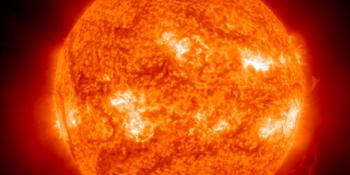Prohlížíte si archiv čtvrtek 19. června 2003
Report sluneční aktivity
Každá zmíněná sluneční erupce v této zprávě má škálovací faktor aplikovaný Střediskem předpovědi kosmického počasí (SWPC). Kvůli škálovacímu faktoru SWPC jsou sluneční erupce hlášeny jako o 42 % menší než u údajů o vědecké kvalitě. Z našich archivovaných dat slunečních erupcí byl odstraněn faktor měřítka, aby odrážel skutečné fyzikální jednotky.
Zpráva o sluneční-geofyzikální činnosti 2003 Jun 19 2200 UTCPřipraveno NOAA © SWPC a zpracováno SpaceWeatherLive.com
Společná zpráva USAF / NOAA o sluneční a geofyzikální činnosti
SDF číslo 170 Vydáno za 2200Z za 19 Jun 2003IA. Analýza solárních aktivních oblastí a aktivity od 18-2100Z do 19-2100Z Solar activity decreased to very low levels. Flare
activity was limited to several B-class flares. Region 386 (S07E30)
lost penumbral coverage over the period although it does retain a
delta magnetic structure in the dominant lead spot. Region 387
(N18E49) grew in both penumbral coverage and magnetic complexity
since yesterday, a gamma structure is now evident in the trailing
portion of the spot group. Newly numbered Region 388 (S03E08)
produced a minor B-class flare early in the period.
IB. Předpověď sluneční aktivity
Solar activity is expected to be at
moderate levels. Region 386 remains capable of producing an
isolated major flare.
IIA. Souhrn geofyzikální aktivity 18-2100Z až 19-2100Z
The geomagnetic field was at predominantly active levels today.
Minor storm conditions were observed at both middle and high
latitudes between 19/0000 and 0300Z due to the influence of a
recurrent high speed coronal hole stream. The greater than 10 MeV
proton flux exceeded event threshold at 18/2050Z (reached a max of
24 pfu at 19/0450Z), ended at 19/1900Z and after careful review the
event is believed to have been the result of the M6.8 x-ray flare
from June 17. The greater than 2 MeV electron flux reached moderate
levels today.
IIB. Předpověď geofyzikální aktivity
The geomagnetic field is
expected to be at predominantly unsettled to active levels through
the interval. Minor storm conditions may exist due to a transient
passage during the first half of day one in response to the M6.8
x-ray flare from June 17.
III. Pravděpodobnosti události 20 Jun až 22 $ 4
| Třída M | 50% | 50% | 50% |
| Třída X | 15% | 15% | 15% |
| Proton | 25% | 15% | 15% |
| PCAF | green | ||
IV. Proud Penticton 10.7 cm
Pozorováno 19 Jun 123 Předpovězeno 20 Jun-22 Jun 125/125/125 90 denní průměr 19 Jun 124
V. Geomagnetické indexy A
Pozorováno Afr/Ap 18 Jun 036/054 Odhadovaný Afr/Ap 19 Jun 023/025 Předpovězeno Afr/Ap 20 Jun-22 Jun 020/025-020/025-012/020
VI. Pravděpodobnosti geomagnetické aktivity 20 Jun až 22 Jun
| A. Střední zeměpisné šířky | |||
|---|---|---|---|
| Aktivní | 40% | 40% | 25% |
| Menší bouře | 15% | 15% | 10% |
| Silná bouře | 10% | 10% | 05% |
| B. Vysoké zeměpisné šířky | |||
|---|---|---|---|
| Aktivní | 50% | 50% | 40% |
| Menší bouře | 20% | 20% | 15% |
| Silná bouře | 10% | 10% | 10% |
Všechny časy v UTC
<< Přejít na stránku s denním přehledem
Poslední zprávy
Nejnovější zprávy na fóru
Incoming & Unnumbered Active Regions 1401AR 3959 20Filaments and prominences 613SEEDS is down? 22Comet C/2024 G3 (ATLAS) in LASCO C3 11
Další témataPodpora SpaceWeatherLive.com!
Mnoho lidí přichází do SpaceWeatherLive, aby sledovali aktivitu Slunce nebo pokud je vidět polární záři, ale s větším provozem přicházejí i vyšší náklady na server. Zvažte dar, pokud vás baví SpaceWeatherLive, abychom mohli udržovat web online!

Fakta o počasí ve vesmíru
| Poslední X-záblesk | 04. 01. 2025 | X1.85 |
| Poslední M-záblesk | 09. 01. 2025 | M1.1 |
| Poslední geomagnetická bouře | 04. 01. 2025 | Kp5 (G1) |
| Dny bez skvrn | |
|---|---|
| Poslední den bez skvrn | 08. 06. 2022 |
| Průměrný měsíční počet slunečních skvrn | |
|---|---|
| prosince 2024 | 154.5 +2 |
| ledna 2025 | 140.8 -13.8 |
| Posledních 30 dnů | 151.7 +34.3 |


